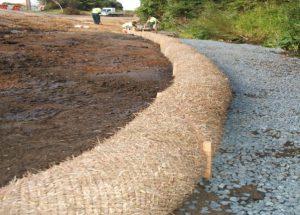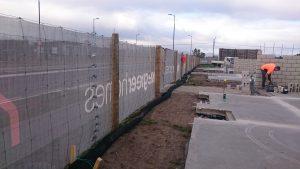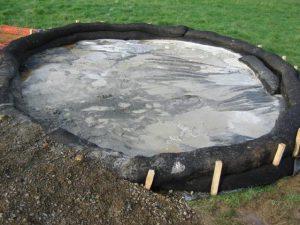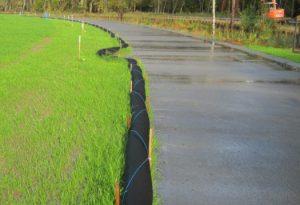Sediment Control
Silt socks
What, why, when, and issues to look out for
What
Silt socks, also called filter socks, are a mesh tube filled with a filter material. This material should be compacted, and could be compost, sawdust, bark or straw, depending on what the sock is to be used for. The socks can either be filled on site or bought as prefabricated lengths.
Why
Silt socks are a stormwater sediment control and filtration device, used to intercept and filter runoff. They temporarily impound sediment-laden runoff, slowing down the flow rate and allowing sediment to settle out of the water.
Silt socks can be used to:
- Intercept and impound sheetflow
- Intercept and impound runoff before it enters a catchpit or other stormwater inlet
- Reduce the velocity of runoff flows within a channel (as a check dam)
- Contain and impound discharges from pumped stormwater or concrete washwater (commonly called a ‘turkey’s nest’).
Silt socks have other uses which are covered in the next section, Stormwater inlets. In brief, they can be used to divert flows and are often used across haul roads when rain is forecast, or at the end of the day. They are also used for catchpit protection and as check structures in diversion drains and flow paths.
When
Silt socks are mainly used in the following situations.
- On small, flat, isolated catchment areas, because their capacity to capture and treat sediment-laden flows is limited
- On small, low gradient sites (eg short batter fills and around watercourses and vegetated or protected areas)
- As a secondary containment and treatment structure when flows can’t be diverted to a sediment retention facility
- When you have to slow the channel velocity
- When you need to treat concrete washwater or pumped stormwater before it is discharged
Issues to look out for
Silt socks have the following limitations.
- Silt socks can only be used in very small catchments.
- Silt socks have a low sediment storage capacity so don’t capture many fine soil particles (for example fine silts, clays and loess), because the water is only detained for a short amount of time behind the sock.
- The filter material inside the sock can settle and compact relatively quickly, which reduces the storage volume and filtration capacity. So silt socks are only appropriate as a short-term control.
- To capture fine sediments, the filter material inside a sock must contain an appropriate proportion of fine material itself. Not all filter socks are equal and you should only use products that are effective for the situation. Check with the supplier whether the product is suitable for capturing fine soils such as loess.
- As a sediment treatment device, they should only be used for sheet flows, not concentrated flows. Using a silt sock as a check dam in channels (to reduce velocities) or placing them where they will intercept concentrated flows, is a separate management approach which is covered in Check dams.
- Silt socks are heavy, especially when wet. You usually need an excavator to move them, to avoid damaging the sock.
- On coarse or uneven terrain, silt socks can be hard to install in complete contact with the ground.
- Silt socks have high maintenance requirements.
- Don’t use silt socks as a standalone treatment device. Use them along with other tools from this toolbox as part of a treatment train, mix and match approach.
- Don’t drive over filter socks, unless the manufacturer and supplier specify that this is all right. When vehicles or machinery are to be moved across a silt sock line, move the sock first and then move it back again. Make sure everyone on site and contractors entering the site are aware of this.
Design essentials
The following design criteria apply to silt socks:
- They should be made from HDPE or polyester material with abrasion-resistant netting weaves (a thread diameter of at least 0.3 mm)
- If using compost as the filter material, the recommended weave is an opening in the knitted mesh of 1–5 mm when full. If using straw, the maximum weave openings should be 20 mm.
- Use the appropriate sized silt sock (see Silt sock design criteria tables).
| Slope steepness | Maximum slope length (m) | Spacing of returns (m) |
|---|---|---|
| Flatter than 2% | 100 | N/A |
| 2–10% | 40 | 30 |
| 10–20% | 30 | 25 |
| 20–33% | 10 | 10 |
| 33–50% | 5 | 10 |
| >50% | 2 | 5 |
| Slope steepness | Maximum slope length (m) | Spacing of returns (m) |
|---|---|---|
| Flatter than 2% | 150 | N/A |
| 2–10% | 60 | 30 |
| 10–20% | 40 | 25 |
| 20–33% | 20 | 10 |
| 33–50% | 10 | 10 |
| > 50% | 5 | 5 |
- Choose the right filter medium (material inside the sock) for the application. Eg, if the sock is to be used as a filter, a porous material like rocks or wood bark won’t work.
- The filter medium must be free from contaminants. Eg, if it is sawdust, it must not be from treated wood. If it is compost or straw, it cannot contain weed seeds.
- If using bark as the filter medium, use 2–10 mm chip. Be aware that bark alone will not capture fine sediments like loess. In this situation use a medium with plenty of fine material.
- If using compost, check it against the specifications in the Silt sock compost media specifications table:
Silt sock compost media specifications table Parameter Unit of measure Specification pH pH units 5.0–8.5 Moisture content % wet weight basis >60 Organic matter content % dry weight basis 25–100 Particle size % passing a selected mesh size, dry weight basis 50 mm, 99% passing; 10 mm, 30–50% passing (or 50–70% retained); maximum 50 mm.
Construction and operation
- Always install silt socks on the contour. If this is not possible, or if the sock is in long sections, install short sock returns, projecting upslope from the silt sock to minimise concentration of flows. Returns should be at least 2 m long.
- If you are using more than one length of silt sock, overlap them by at least 1 m or, according to the manufacturer’s recommendation, and joined by a sleeve.
- Install silt sock ‘wings’ at either end of the silt sock, projecting a sufficient length upslope to prevent outflanking.
- Silt socks are to be pegged and secured depending on the application.
- Silt socks using a light filter medium such as straw or wood chips must be tied down using stakes and twine to prevent ‘floating’. So you will not be able to use these on impervious surfaces such as concrete or seal. These socks are often not effective in capturing fine sediments such as loess, so socks containing fines, such as compost are better.
For additional security, bale twine may be used. The bale twine is secured (four turns with a half hitch) to the pine stakes and tensioned when the stakes are driven into place.
-
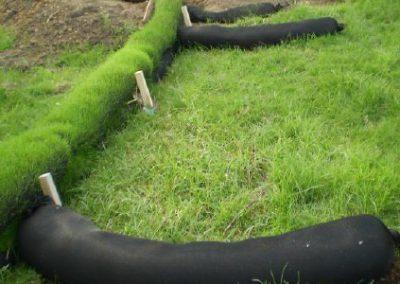
Compost silt socks with returns installed.
-

Silt sock with 1 m overlapping joint.
-
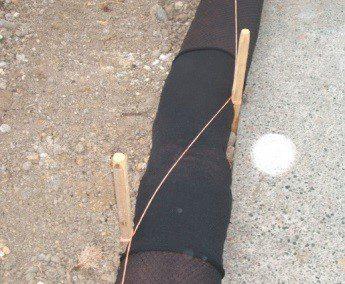
Silt sock joined using a sleeve and pegged and secured using bailing twine with 1 m overlapping joint (Source: Erosion Control Ltd).
-
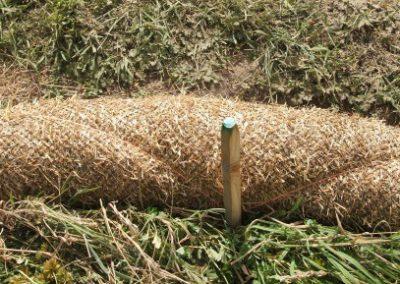
Straw sock secured in place using stakes and bale twine; note the stakes are placed every 600 mm.
When making ‘turkey’s nests’
- Set up a ring of silt socks, with the proposed pumping discharge point in the centre of the ring
- Make sure that the treated discharge from the turkey’s nest won’t cause erosion or the sediment to be remobilised
- The size of the ring will depend on the flows that are to be pumped – the ring should not be overtopped
- Use a flooring membrane to collect settled debris.
Maintenance and decommissioning
When maintaining silt socks
- Inspect them regularly and after each rainfall to make sure that they are working and not being outflanked.
- Remove sediment that has accumulated to 20% of the height of the silt sock, or else put another silt sock on top to maintain adequate sediment control.
- You can reuse silt socks if you maintain the integrity of the sock and filter material.
- Move the silt sock out of the way of vehicles and machinery instead of driving over them, as this will destroy them. Put the silt sock back once vehicle movements are completed.
- If the forecast is for dry weather and equipment will be moving across the area where silt socks are placed, remove them and reinstall them before it rains.
When decommissioning silt socks
- Stabilise the catchment area
- Remove the silt sock
- Remove and dispose of the accumulated sediment.
